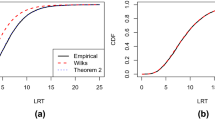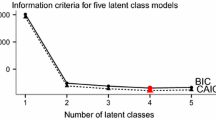Abstract
Binary data latent class analysis is a form of model-based clustering applied in a wide range of fields. A central assumption of this model is that of conditional independence of responses given latent class membership, often referred to as the “local independence” assumption. The results of latent class analysis may be severely biased when this crucial assumption is violated; investigating the degree to which bivariate relationships between observed variables fit this hypothesis therefore provides vital information. This article evaluates three methods of doing so. The first is the commonly applied method of referring the so-called “bivariate residuals” to a Chi-square distribution. We also introduce two alternative methods that are novel to the investigation of local dependence in latent class analysis: bootstrapping the bivariate residuals, and the asymptotic score test or “modification index”. Our Monte Carlo simulation indicates that the latter two methods perform adequately, while the first method does not perform as intended.



Similar content being viewed by others
References
Agresti A (2002) Categorical data analysis, 2nd edn. Wiley-Interscience, New York
Ahlquist JS, Breunig C (2012) Model-based clustering and typologies in the social sciences. Polit Anal 20(1):92–112
Albert P, Dodd L (2004) A cautionary note on the robustness of latent class models for estimating diagnostic error without a gold standard. Biometrics 60(2):427–435
Baughman A, Bisgard K, Cortese M, Thompson W, Sanden G, Strebel P (2008) Utility of composite reference standards and latent class analysis in evaluating the clinical accuracy of diagnostic tests for pertussis. Clin Vaccine Immunol 15(1):106–114
Chen F, Mackey A, Vermunt J, Roos D (2007) Assessing performance of orthology detection strategies applied to eukaryotic genomes. PLoS One 2(4):e383
Collins LM, Lanza ST (2010) Latent class and latent transition analysis: with applications in the social, behavioral, and health sciences, vol 718. Wiley, New York
Efron B (1982) The Jackknife, the bootstrap, and other resampling plans. In: Proceedings of the CBMS-NSF Regional Conference Series in Applied Mathematics, Society for Industrial and Applied Mathematics (SIAM), Philadelphia
Evers M, Namboodiri N (1979) On the design matrix strategy in the analysis of categorical data. Sociol Methodol 10:86–111
Faraone S, Tsuang M (1994) Measuring diagnostic accuracy in. Am J Psychiatry 1(51):651
Forcina A (2008) Identifiability of extended latent class models with individual covariates. Comput Stat Data Anal 52(12):5263–5268
Formann A (1992) Linear logistic latent class analysis for polytomous data. J Am Stat Assoc 87(418): 476–486
Gaffikin L, McGrath J, Arbyn M, Blumenthal P (2007) Visual inspection with acetic acid as a cervical cancer test: accuracy validated using latent class analysis. BMC Med Res Methodol 7(1):36
Gallego A, Oberski D (2012) Personality and political participation: the mediation hypothesis. Polit Behav 34:424–451
Glas C (1998) Detection of differential item functioning using Lagrange multiplier tests. Stat Sinica 8: 647–668
Glas C (1999) Modification indices for the 2-PL and the nominal response model. Psychometrika 64(3): 273–294
Goodman L (1974) Exploratory latent structure analysis using both identifiable and unidentifiable models. Biometrika 61(2):215
Hadgu A, Dendukuri N, Hilden J (2005) Evaluation of nucleic acid amplification tests in the absence of a perfect gold-standard test: a review of the statistical and epidemiologic issues. Epidemiology 16(5): 604–612
Hagenaars JAP (1988) Latent structure models with direct effects between indicators local dependence models. Sociol Methods Res 16(3):379–405
Hagenaars JAP, McCutcheon AL (2002) Applied latent class analysis. Cambridge University Press, Cambridge
Heinen T (1996) Latent class and discrete latent trait models: similarities and differences. Sage, Thousand Oaks
Hofmann T (2001) Unsupervised learning by probabilistic latent semantic analysis. Mach Learn 42(1): 177–196
Hope T, Norris PA (2012) Heterogeneity in the frequency distribution of crime victimization. J Quant Criminol. doi:10.1007/s10940-012-9190-x
Huang G, Bandeen-Roche K (2004) Building an identifiable latent class model with covariate effects on underlying and measured variables. Psychometrika 69(1):5–32
Hybels C, Blazer D, Pieper C, Landerman L, Steffens D (2009) Profiles of depressive symptoms in older adults diagnosed with major depression: a latent cluster analysis. Am J Geriatr Psychiatry 17(5):387
Langeheine R, Pannekoek J, Van de Pol F (1996) Bootstrapping goodness-of-fit measures in categorical data analysis. Sociol Methods Res 24(4):492–516
Laumann EO, Paik A, Rosen RC (1999) Sexual dysfunction in the United States. JAMA 281(6):537–544
Maydeu-Olivares A, Joe H (2005) Limited-and full-information estimation and goodness-of-fit testing in \(2^n\) contingency tables. J Am Stat Assoc 100(471):1009–1020
McLachlan G, Peel D (2000) Finite mixture models volume 299. Wiley-Interscience, New York
Nyholt D, Gillespie N, Heath A, Merikangas K, Duffy D, Martin N (2004) Latent class and genetic analysis does not support migraine with aura and migraine without aura as separate entities. Genet Epidemiol 26(3):231–244
R Core Team (2012) R: A Language and Environment for Statistical Computing. R Foundation for Statistical Computing, Vienna, Austria. ISBN 3-900051-07-0
Rao CR (1948) Large sample tests of statistical hypotheses concerning several parameters with applications to problems of estimation. In: Proceedings of the Cambridge philosophical society, vol 44, pp 50–57. Cambridge University Press, Cambridge
Saris W, Satorra A, Sörbom D (1987) The detection and correction of specification errors in structural equation models. Sociol Methodol 17:105–129
Satorra A (1989) Alternative test criteria in covariance structure analysis: a unified approach. Psychometrika 54(1):131–151
Savage M, Devine F, Cunningham N, Taylor M, Li Y, Hjellbrekke J, Le Roux B, Friedman S, Miles A (2013) A new model of social class? Findings from the BBC’s Great British Class Survey Experiment. Sociology 47(2):219–250
Sörbom D (1989) Model modification. Psychometrika 54(3):371–384
Tay L, Newman D, Vermunt J (2011) Using mixed-measurement item response theory with covariates (MM-IRT-C) to ascertain observed and unobserved measurement equivalence. Organ Res Methods 14(1):147–176
Torrance-Rynard V, Walter S (1998) Effects of dependent errors in the assessment of diagnostic test performance. Stat Med 16(19):2157–2175
Vacek P (1985) The effect of conditional dependence on the evaluation of diagnostic tests. Biometrics 41(4):959–968
van der Linden W, Glas C (2010) Statistical tests of conditional independence between responses and/or response times on test items. Psychometrika 75(1):120–139
Vermunt JK, Magidson J (2005) Technical guide for latent GOLD 4.0: Basic and advanced. Statistical Innovations Inc, Belmont
Walter S, Irwig L (1988) Estimation of test error rates, disease prevalence and relative risk from misclassified data: a review. J Clin Epidemiol 41(9):923–937
Walter SD, Riddell CA, Rabachini T, Villa LL, Franco EL (2013) Accuracy of p53 codon 72 polymorphism status determined by multiple laboratory methods: a latent class model analysis. PloS one 8(2):e56430
White N, Johnson H, Silburn P, Mellick G, Dissanayaka N, Mengersen K (2012) Probabilistic subgroup identification using bayesian finite mixture modelling: a case study in Parkinson’s disease phenotype identification. Stat Methods Med Res 21(6):563–583
Author information
Authors and Affiliations
Corresponding author
Rights and permissions
About this article
Cite this article
Oberski, D.L., van Kollenburg, G.H. & Vermunt, J.K. A Monte Carlo evaluation of three methods to detect local dependence in binary data latent class models. Adv Data Anal Classif 7, 267–279 (2013). https://doi.org/10.1007/s11634-013-0146-2
Received:
Revised:
Accepted:
Published:
Issue Date:
DOI: https://doi.org/10.1007/s11634-013-0146-2
Keywords
- Conditional dependence
- Latent variable models
- Score test
- Lagrange multiplier test
- Modification index
- Bivariate residuals




